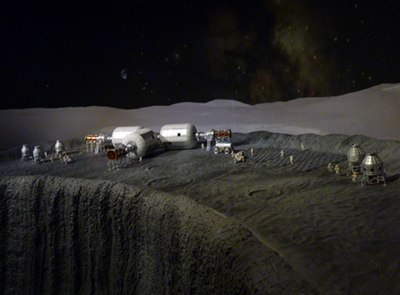Review: Beyond Planet Earthby Jeff Foust
|
| The exhibit offers some interesting concepts of what the future of space exploration would be like, but there are some missing elements. |
The exhibit starts with some history, featuring a mix of replicas (models of Sputnik 1 and Vostok 1) and some authentic items (a cosmonaut’s helmet and gloves from a NASA spacesuit). There’s also a full-sized model of NASA’s Mars Exploration Rover and a small scale model of Virgin Galactic’s WhiteKnightTwo and SpaceShipTwo to represent the present of spaceflight and space exploration. The heart of the exhibit, though, is its depictions of potential futures for space exploration: a model of a lunar base (based on concepts developed by Bigelow Aerospace), a lunar space elevator model, human exploration of Mars, and even terraforming of the Red Planet.
The exhibit is more than just models and artifacts, though. There is some multimedia and interactive elements, including a tabletop multitouch display where people can play with simulations regarding the terraforming of Mars. One of the more novel tools, though, is an “augmented reality” app available for iPhones. Start the app and point the phone’s camera at a one of several special icons on the exhibit’s displays and a 3-D model related to a particular item—a model of a Mars spaceship, a depiction of the solar system, etc.—appears on the screen. (I recommend that you download the free app before starting your visit; you can download it while you tour, if you don’t mind fumbling with your phone while trying not to be a nuisance to others.) Outside of the exhibit the app isn’t very useful, although you can download copies of the icons to recreate the visualizations.
 The exhibition’s “augmented reality” iPhone app in action, creating an illustration of an asteroid on the screen. (credit: J. Foust) |
The exhibit offers some interesting concepts of what the future of space exploration would be like, but there are some missing elements. Carrying out these concepts for missions to the Moon, Mars, and beyond will almost certainly require advances in space transportation that offer improvements in cost and performance, yet there’s little discussion of rockets or in-space transportation. The models of lunar bases and space elevators are interesting, but the exhibit doesn’t devote much detail about why to develop them, and at what cost. People may be wowed by the visions for exploration on display, but unless they’re already predisposed to the idea of human exploration of space—not an unreasonable assessment given the self-selection involved with deciding to pay to attend the exhibit—the models and other aspects of the exhibit may not close the case why they should support it.
Those omissions aside, “Beyond Space Exploration” is an interesting exhibit given its focus on the future—or, rather, a future—rather than the past, and worth a visit for those in the New York area or planning to make a visit before the exhibit closes in August. (The exhibit is not included in the museum’s general admission; it requires purchase of at least a “Museum Plus One Admission”, which costs $25 for adults versus $19 for general admission. Exhibit tickets are time-stamped to meter crowds through an exhibit that has limited—ahem—space.) Perhaps it will inspire someone to examine what it takes, technologically and otherwise, to translate those models and concepts on display into reality.
